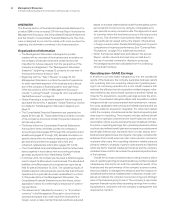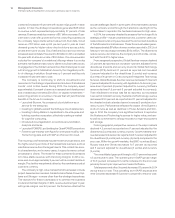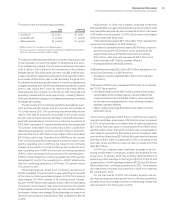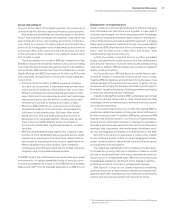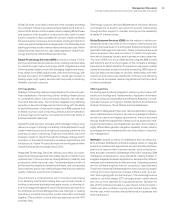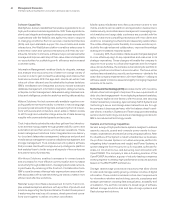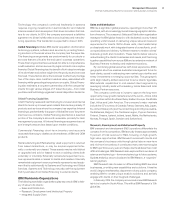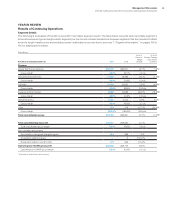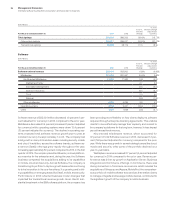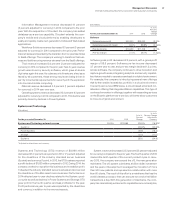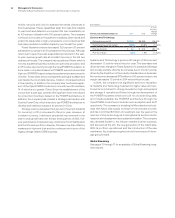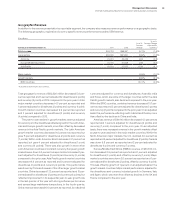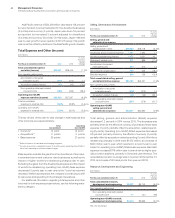IBM 2014 Annual Report Download - page 32
Download and view the complete annual report
Please find page 32 of the 2014 IBM annual report below. You can navigate through the pages in the report by either clicking on the pages listed below, or by using the keyword search tool below to find specific information within the annual report.31
Management Discussion
International Business Machines Corporation and Subsidiary Companies
Technology: the company’s continued leadership in systems
requires ongoing investments in semiconductor and material
science research and development that drives innovation that mat-
ters for our clients. In 2014, the company announced a definitive
agreement to divest its Microelectronics business and manufac-
turing operations. This transaction is expected to close in 2015.
Global Financing facilitates IBM clients’ acquisition of information
technology systems, software and services by providing financ-
ing solutions in the areas where the company has the expertise.
The financing arrangements are predominantly for products or
services that are critical to the end users’ business operations.
These financing contracts are entered into after a comprehensive
credit evaluation and are secured by legal contracts. As a captive
financier, Global Financing has the benefit of both deep knowledge
of its client base and a clear insight into the products and services
financed. These factors allow the business to effectively manage
two of the major risks, credit and residual value, associated with
financing while generating strong returns on equity. Global Financ-
ing also maintains a long term partnership with the companies’
clients through various stages of IT asset life cycle—from initial
purchase and technology upgrades to asset disposition decisions.
Global Financing Capabilities
Client Financing: lease and loan financing to end users and internal
clients for terms up to seven years. Assets financed are primarily IT
products and services where the company has expertise. Internal
financing is predominantly in support of Global Services’ long-term
client service contracts. Global Financing also factors a selected
portion of the company’s accounts receivable, primarily for cash
management purposes. All internal financing arrangements are at
arm’s-length rates and are based upon market conditions.
Commercial Financing: short-term inventory and accounts
receivable financing to dealers and remarketers of IBM and OEM
products.
Remanufacturing and Remarketing: used equipment is returned
from lease transactions, or may be surplus equipment inter-
nally or externally purchased. These assets may be refurbished
or upgraded and sold or leased to new or existing clients both
externally or internally. Externally remarketed equipment reve-
nue represents sales or leases to clients and resellers. Internally
remarketed equipment revenue primarily represents used equip-
ment that is sold internally to Systems and Technology and Global
Services. Systems and Technology may also sell the equipment
that it purchases from Global Financing to external clients.
IBM Worldwide Organizations
The following worldwide organizations play key roles in IBM’s deliv-
ery of value to its clients:
• Sales and Distribution
• Research, Development and Intellectual Property
• Integrated Supply Chain
Sales and Distribution
IBM has a significant global presence, operating in more than 175
countries, with an increasingly broad-based geographic distribu-
tion of revenue. The company’s Sales and Distribution organization
manages the IBM global footprint, with dedicated country-based
operating units focused on delivering unique value and superior
experiences for clients. Within these units, client relationship
professionals work with integrated teams of consultants, prod-
uct specialists and delivery fulfillment teams to enable clients’
business growth and innovation. These teams deliver value by
understanding the clients’ businesses and needs, and then bring
together capabilities from across IBM and an extensive network of
Business Partners to develop and implement solutions.
By combining global expertise with local experience, IBM’s
geographic structure enables dedicated management focus for
local clients, speed in addressing new market opportunities and
timely investments in emerging opportunities. The geographic
units align industry-skilled resources to serve clients’ agendas.
IBM extends capabilities to mid-market client segments by
leveraging industry skills with marketing, Inside Sales and local
Business Partner resources.
The company continues to invest to capture the long-term
opportunity in key growth markets around the world—China, India
and countries within Southeast Asia, Eastern Europe, the Middle
East, Africa and Latin America. The company’s major markets
include the G7 countries of Canada, France, Germany, Italy, Japan,
the United States (U.S.) and the United Kingdom (UK) plus Austria,
the Bahamas, Belgium, the Caribbean region, Cyprus, Denmark,
Finland, Greece, Iceland, Ireland, Israel, Malta, the Netherlands,
Norway, Portugal, Spain, Sweden and Switzerland.
Research, Development and Intellectual Property
IBM’s research and development (R&D) operations differentiate the
company from its competitors. IBM annually invests approximately
6percent of total revenue for R&D, focusing on high-growth,
high-value opportunities. IBM Research works with clients and
the company’s business units through global labs on near-term
and mid-term innovations. It contributes many new technologies
to IBM’s portfolio every year and helps clients address their most
difficult challenges. IBM Research also explores the boundaries of
science and technology—from nanotechnology to future systems,
big data analytics, secure clouds and to IBM Watson, a ‘‘cognitive’’
learning system.
IBM Research also focuses on differentiating IBM’s services
businesses, providing new capabilities and solutions. It has the
world’s largest mathematics department of any public company,
enabling IBM to create unique analytic solutions and actively
engage with clients on their toughest challenges.
In February 2015, the company announced a new IBM Research
lab to be located in South Africa. This will be IBM Research’s 13th
global lab.



